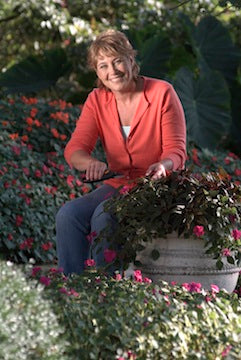Harvest time
Keeping it fresh from the garden to the table
By Melinda Myers
You spent the summer weeding, watering and tending to your vegetable garden. Now all your effort has paid off with a bountiful harvest.
Maximize the flavor and nutritional value of your homegrown vegetables with proper harvesting and storage. For the freshest flavor, always prepare and serve vegetables immediately after harvest. But let's face it, most of us are living busy lives and lucky to get the vegetables picked and eventually cooked.
Plus, all the extras will need to be shared, preserved or stored for future enjoyment.
Here are a few things you can do to keep the flavor fresh.
Handle produce with care. Nicking, breaking and bruising the vegetables during harvest decreases storage life and quality. Harvest leafy crops such as lettuce, kale, and collards last as they quickly wilt after harvest. And with the wilting goes the ascorbic acid (Vitamin C).
Ideally, vegetables you plan to prepare immediately should be cleaned outdoors. You’ll keep garden soil out of the kitchen sink and in the garden where it belongs. Collect your veggies in an open weave wire or plastic harvest basket like the Mod Hod. Its fold out legs allow the produce to dry before bringing it indoors. Rinse off the soil with the hose, drain excess water and carry your veggies into the kitchen to prepare.
Clean your counters and cutting boards before you start slicing, cutting and dicing your vegetables.
Trim stems, remove damaged leaves and compost these in the garden or worm bin. They will have a second life as compost in next year’s garden.
Wait to wash, trim, and clean the vegetables you plan to store or prepare later. The scraping, cutting and slicing process increases the loss of vitamins and flavor and reduces storage quality.
Increase storage longevity by matching vegetables with their preferred storage conditions. The closer you come to this, the longer your produce will last.
Store roots crops like beets, turnips and radishes as well as cabbage and Brussels sprouts in a cold, moist condition. A spare refrigerator works great for these.
People in colder climates can store their carrots and parsnips right in the garden. Once the soil gets a bit crunchy, cover them with straw or evergreen boughs for easier digging in winter. Then dig as needed or harvest during the first winter thaw.
Keep potatoes in a cool, humid and dark location like a cool corner in the basement. Sunlight causes the exposed portions to produce green chlorophyll and solanine, a glycoalkaloid toxin. The solanine gives the potatoes a bitter flavor and can cause vomiting and diarrhea if enough green potatoes are eaten. Just cut away any green portions before using.
Store winter squash in a cool location as well. They can tolerate a bit lower humidity and last for four months or more when properly harvested and stored.
Use slatted crates or other vegetable storage solutions (gardeners.com) to maximize storage space and increase storage longevity. These systems provide ample storage space, so fruits and vegetables do not touch. Keeping stored fruit separated prevents rot from spreading from one fruit to the next. Plus, the slatted sides allow airflow to extend storage longevity.
A few simple changes in handling your harvest will improve its storage life, flavor, and nutritional quality. Better quality means less waste and more abundance for cooking and sharing.
Follow these harvesting tips to enjoy garden-fresh meals throughout the remainder of the growing season. Then continue creating tasty meals reminiscent of the garden season with properly stored produce long after your harvest is past.
ABOUT THE AUTHOR
Melinda Myers
Melinda Myers has written more than 20 gardening books, including Small Space Gardening. She hosts The Great Courses “How to Grow Anything: Food Gardening For Everyone” DVD set and the nationally syndicated Melinda’s Garden Moment TV & radio segments. Myers is a columnist and contributing editor for Birds & Blooms magazine and was commissioned by Gardener’s Supply for her expertise to write this article.




